英汉翻译中的显化和隐化
- 格式:doc
- 大小:27.00 KB
- 文档页数:4
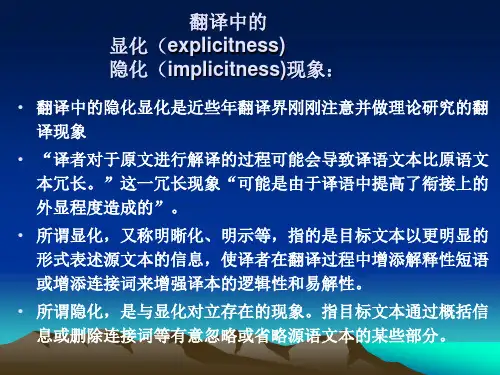
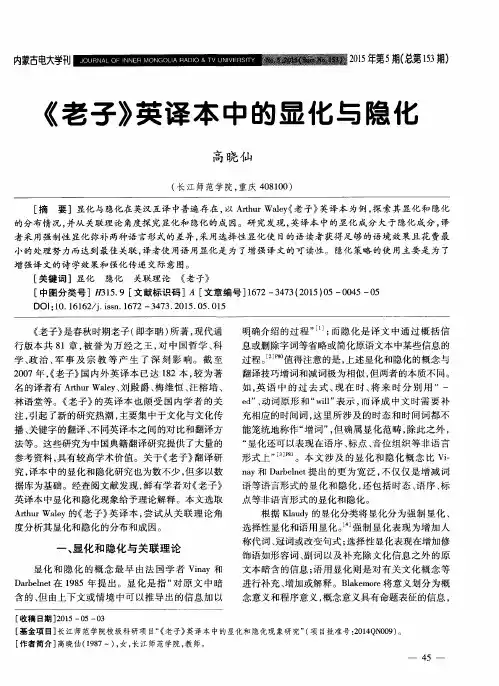
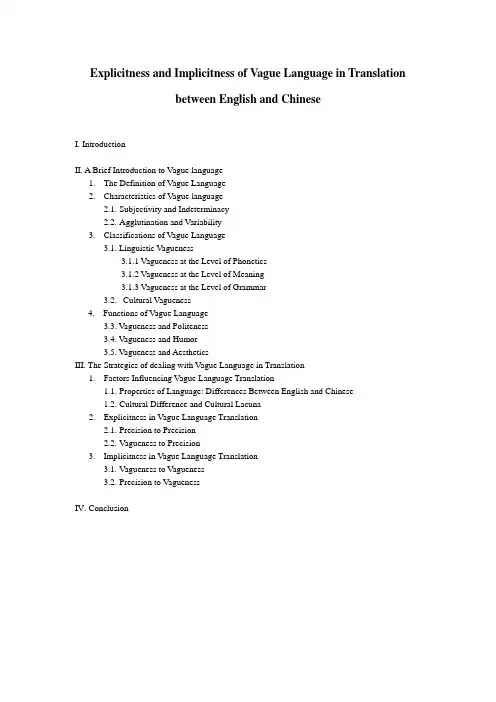
Explicitness and Implicitness of V ague Language in Translationbetween English and ChineseI. IntroductionII. A Brief Introduction to V ague language1.The Definition of V ague Language2.Characteristics of V ague language2.1.Subjectivity and Indeterminacy2.2.Agglutination and V ariability3.Classifications of V ague Language3.1. Linguistic V agueness3.1.1 V agueness at the Level of Phonetics3.1.2 V agueness at the Level of Meaning3.1.3 V agueness at the Level of Grammar3.2.Cultural V agueness4. Functions of V ague Language3.3.V agueness and Politeness3.4.V agueness and Humor3.5.V agueness and AestheticsIII. The Strategies of dealing with V ague Language in Translation1.Factors Influencing V ague Language Translation1.1.Properties of Language: Differences Between English and Chinese1.2.Cultural Difference and Cultural Lacuna2.Explicitness in V ague Language Translation2.1.Precision to Precision2.2.V agueness to Precision3.Implicitness in V ague Language Translation3.1.V agueness to V agueness3.2.Precision to V aguenessIV. ConclusionⅠ.IntroductionThe emergence and development of language has experienced a long time, so dose human‟s understanding of language. People‟s research on language has always laid particular stress on “precision”. The more precise, the better. But the reality is usually unsatisfactory. For the absolute precision is very hard to achieve and now people have found there is no absolutely clear things in the world. In our daily communication, the meaning we imparted is sometimes inevitably inadequate or unclear which lead to the misunderstanding of the receiver. Even facing the same thing different people give different views. That is the vagueness of language.Since the publication of fuzzy sets by L.A.zadeh, un expert on automatic control, many disciplines related to vagueness have sprouted up across the world, as J.Channell states :”Interests in vagueness in language use and meaning has arisen in a number of disciplines: literary criticism, linguistics, psychology, philosophy.”(p5) Among them the study on vague language has gained more and more attentions. In China, Vague Linguistics by Wu Tieping, a famous linguist, may be rated as the foundation stone of the study on vague language. In language communication, vague language is not only unavoidable but also necessary. In many cases, it can make language expression more natural and more appropriate. Just as Kant believes:”vague concepts are more expressive than clear concepts…beauty should be something that can not be explained in words. We cannot always convey what we think by words. ”(Wu Tieping p44) thus it can be seen that vague language has its own advantages in communication.Nowadays communications become more frequent between people of different languages and cultural backgrounds. Therefore translation plays an important role in the exchange of information which is bound to involve the study of language. V agueness in language becomes an inevitable and indispensable phenomenon in translation. Now vagueness has no longer been a new term in translation field and it adds much difficulty to the transfer of meaning from the source to the target language for languages is usually not share the same vagueness. The vagueness of language has much to do with culture, politics, economy and other non-linguistic factors.V ague language widely exists in many aspects of our life. More and more translators have explored the strategies of dealing with vague language in translation. In this paper the author presents two methods: explicitation and implicitation after the analysis of vague language.The author attempts to find the effective ways to deal with vague language in translation upon the basis of a brief understanding of vague language in order to offer help to the translation.II. A Brief Introduction to V ague LanguageThe appearance of vagueness can be traced back to the publication of the article Fuzzy Sets by L.A.Zadeh in which he states that the objects in material world have no definite boundaries. The meaning of vagueness has been enriched with the development of science and technology and the expansion of human activity in time and space. Vague language as a branch of the whole findings is the main focus of this chapter.2.1. The Definition of VaguenessAs for the definition of vague language, different scholars or researchers have different answers, for things become different when we look at them from different angles.Peirce, un American famous philosophy and mathematician, is perhaps the first to try to elaborate the notion in a rigorous way. He says:A proposition is vague where there are possible states of things concerningwhich it is intrinsically uncertain whether, had they been contemplated by thespeaker, he would have regarded them as excluded or allowed by theproposition. By intrinsically uncertain we mean not uncertain in consequenceof any ignorance of the interpreter, but because the speaker‟s habits oflanguage were indeterminate. (Channell p7)Another approach to vagueness is found in Deese‟s work which is more psychologically-oriented. He claims that vagueness is not a concept that applies to language but to the meanings which language expresses. That is, it is the meanings that is vague but not the language itself. He says:…that the correspondence between the ideas possessed by two individualswho are in communication on a common topic is rather poor, a conditionwhich we ordinarily do not notice because we seldom make explicit attemptsto validate a communicated idea against the original. When we do, as in thecase of giving directions to someone about how to do something, we aresuddenly made aware of the discrepancy that exists between …the same‟ideain the minds of two different people.(Channell p8)Upon this question, many domestic scholars has also achieved a lot. Mao Ronggui discusses the esthetic effect of vague language in his Translation Esthetics. He regarded vague language as that “the words has indistinct and wide semantic extension. It is not ”.Generally speaking, vagueness refers to such a fact that there are no clear-cut boundaries between two concepts. It isn‟t a bad thing, far from it, vagueness and precision are, like the two sides of a coin, essential part of language system.2.2. Characteristics of vague languageV agueness is an inherent nature of language. After knowing its definition, it is still unclear that how to judge whether a word is vague or not. So it is meaningful for us to discuss the characteristics of vague language, such as subjectivity, indeterminacy, agglutination and variability, to name a few of them.2.2.1. Subjectivity and IndeterminacyWe all know that opinions vary from person to person. When we describe something or express our views vague language appears. Different experiences and outlooks make everyone see things differently, so the denotation of vague language varies according to his/her own way of understanding. For example, we each have different views on what kind of women is beautiful. When facing the same woman, someone may think she is beautiful while others do not which is resulted from the subjectivity of the word “beautiful”. The reasons of the discrepancy of the comprehension of the same concept lie in different experiences and background.The indeterminacy of vague language refers to the uncertain membership of some cases. Some words are vague when we talk about color words. For instance, everybody knows that the leaves are green in summer and turn yellow gradually in autumn. But if we take one leaf in early autumn it is not easy to tell whether the leaf is green or yellow. It may be a bit green with some sort of a yellow color. So we usually hear such vague words as yellowish green. Another case is that the explanation given by dictionary is thick yellowish white liquor floated on the milk. From the word “yellowish white”we can see the cream may be white with somewhat yellow. In reality, the color words are not clearly divided as the color in spectrum.2.2.2. Agglutination and V ariabilityThe agglutination of vague language means that some vague language is a continuum and there are no clear-cut dividing lines between them. This feature can find its best expression in vague language indicating space or time. Time and space are actually continuums without fixed and unchangeable boundaries to divide them. Each language can divide them according to its own structure. When we talk about time in our daily life, we say morning, afternoon, evening or night. But there are no well-defined borders among them. Although the central area is clear, the peripheral area is vague. Since they happen one after another, sometimes we cannot tell which period we are in, because they often overlap.The variability of vague language refers to two aspects. Firstly, vague language is not always vague. In some cases, it may assume an accurate meaning. V ague words can become precise ones by collocating with other words. For example, the word “long”is vague. There are no rules telling that how long can be regarded as “long”. But it is precise in “long wave”whose wavelength is from 1000m to 10000m in physics. Many terms, although literally vague, are accurate when used in certain field of study. Colors, like red, orange, yellow without distinct boundaries, are prescribed strictly by scientists, namely, red ranges from 6200 to 7000 angstrom, orange from 5920 to 6200, and yellow between 5780 and 5920. From above examples we can see that in academic field it is necessary to define a term rigorously while in our daily life it‟s enough to use them in their vague sense. Secondly, it means the range a vague category covers may vary. The scope of a vague category is either enlarged or narrowed. Generally speaking, this kind of variability comes from some factors such as gender, culture and social status. Let‟s take “night”for example; the scope of night varies as the season changes. That period is long in winter and short in summer. Many words share the same characteristics. A big rat is much smaller than a small elephant. As we can see, the scope of these kinds of vague words changes in consistent with thecontext they are in. There are two people. One is from New Y ork; the other comes from a small village. They are likely to have different ideas on “tall building”. A large number of skyscrapers are found in New Y ork. They may take a building with 40 stories as a tall one, while a building with 10 floors is considered tall for a people from a small village. This situation should be taken into account when we do translation work. For many difficulties in translation originate in the great gap of social difference.Of all the characteristics we have talked about, the indeterminacy is the most prominent one.2.3. Classifications of Vague LanguageThe classification of vague language is helpful for both its study and its translation. But in this matter the scholars didn‟t reach an agreement as its definition does. Some researchers classify it from different levels of language, some others according to the part of speech.Some linguists divide vague language into three parts: vague additives, vagueness by choice of vague words, vagueness by implicative.(具体见翻译的模糊性及翻译中的模糊处理论文) (Channell, 1999: 18) Zhang Qiao, a famous linguist in our country, also thinks that vague language has many types under different classified method. According to the part of speech, there are vague nouns(say past, present, future), vague adjectives(say beautiful, healthy, red) and vague quantifiers(say several, some, a lot of); according to the extension of vague language, there are vague words with indefinite top limit(e.g. a short person, a young person, cold water), vague words with indefinite lower limit(e.g. a tall person, an old people, hot water) and vague words with both indefinite top and indefinite lower limit(e.g. a middle sized person, a middle aged person, warm water).In this paper we‟ll discuss the types of vague language at the linguistic level.2.3.1. Linguistic Vagueness2.3.1.1. V agueness at the Level of PhoneticsThe effect of this kind of vagueness often comes from homophony or hearing delusion. It usually appears in the pun to achieve the intended humor. For example: The professor tapped on his desk and shouted:”Young men, Order!”—the entire class yelled:” Beer!”Translation: 教授敲击桌子喊道:你们这些年轻人吆喝(要喝)什么?学生:啤酒。

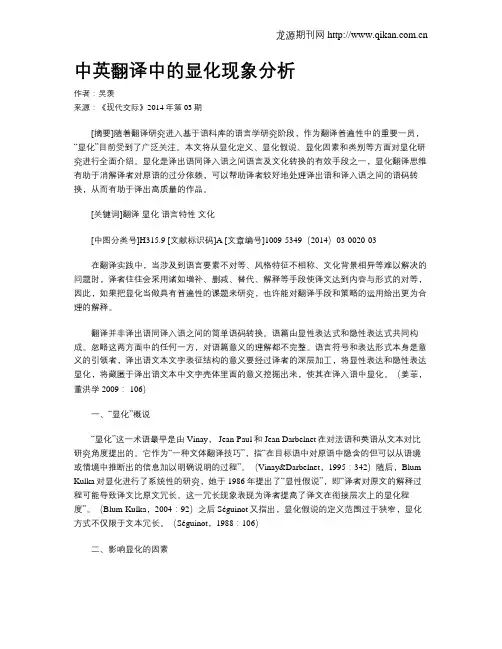
中英翻译中的显化现象分析作者:吴羡来源:《现代交际》2014年第03期[摘要]随着翻译研究进入基于语料库的语言学研究阶段,作为翻译普遍性中的重要一员,“显化”目前受到了广泛关注。
本文将从显化定义、显化假说、显化因素和类别等方面对显化研究进行全面介绍。
显化是译出语同译入语之间语言及文化转换的有效手段之一,显化翻译思维有助于消解译者对原语的过分依赖,可以帮助译者较好地处理译出语和译入语之间的语码转换,从而有助于译出高质量的作品。
[关键词]翻译显化语言特性文化[中图分类号]H315.9 [文献标识码]A [文章编号]1009-5349(2014)03-0020-03在翻译实践中,当涉及到语言要素不对等、风格特征不相称、文化背景相异等难以解决的问题时,译者往往会采用诸如增补、删减、替代、解释等手段使译文达到内容与形式的对等,因此,如果把显化当做具有普遍性的课题来研究,也许能对翻译手段和策略的运用给出更为合理的解释。
翻译并非译出语同译入语之间的简单语码转换。
语篇由显性表达式和隐性表达式共同构成。
忽略这两方面中的任何一方,对语篇意义的理解都不完整。
语言符号和表达形式本身是意义的引领者,译出语文本文字表征结构的意义要经过译者的深层加工,将显性表达和隐性表达显化,将藏匿于译出语文本中文字壳体里面的意义挖掘出来,使其在译入语中显化。
(姜菲,董洪学 2009: 106)一、“显化”概说“显化”这一术语最早是由Vinay, Jean-Paul和Jean Darbelnet在对法语和英语从文本对比研究角度提出的。
它作为“一种文体翻译技巧”,指“在目标语中对原语中隐含的但可以从语境或情境中推断出的信息加以明确说明的过程”。
(Vinay&Darbelnet,1995:342)随后,Blum-Kulka对显化进行了系统性的研究,她于1986年提出了“显性假说”,即“译者对原文的解释过程可能导致译文比原文冗长。
这一冗长现象表现为译者提高了译文在衔接层次上的显化程度”。
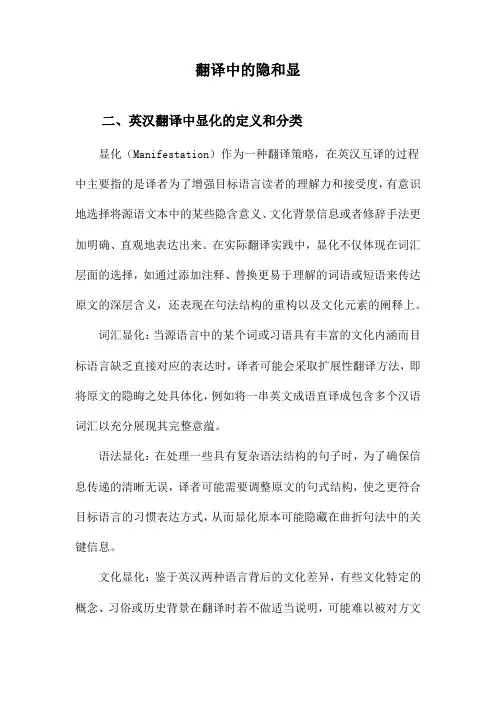
翻译中的隐和显二、英汉翻译中显化的定义和分类显化(Manifestation)作为一种翻译策略,在英汉互译的过程中主要指的是译者为了增强目标语言读者的理解力和接受度,有意识地选择将源语文本中的某些隐含意义、文化背景信息或者修辞手法更加明确、直观地表达出来。
在实际翻译实践中,显化不仅体现在词汇层面的选择,如通过添加注释、替换更易于理解的词语或短语来传达原文的深层含义,还表现在句法结构的重构以及文化元素的阐释上。
词汇显化:当源语言中的某个词或习语具有丰富的文化内涵而目标语言缺乏直接对应的表达时,译者可能会采取扩展性翻译方法,即将原文的隐晦之处具体化,例如将一串英文成语直译成包含多个汉语词汇以充分展现其完整意蕴。
语法显化:在处理一些具有复杂语法结构的句子时,为了确保信息传递的清晰无误,译者可能需要调整原文的句式结构,使之更符合目标语言的习惯表达方式,从而显化原本可能隐藏在曲折句法中的关键信息。
文化显化:鉴于英汉两种语言背后的文化差异,有些文化特定的概念、习俗或历史背景在翻译时若不做适当说明,可能难以被对方文化圈的读者所理解。
文化显化包括将原文中潜在的文化暗示直接翻译并加以解释,或者采用类比、注解等方式让目标读者能够把握原文的文化含义。
英汉翻译中的显化是一种旨在跨越语言与文化鸿沟,实现有效沟通的重要手段,它要求译者在忠实于原文的同时,具备敏锐的文化洞察力和灵活的语言运用能力,以恰如其分的方式揭示原文中那些可能被目标语言读者所忽视的隐含信息。
1. 语义显化:将原文中的隐含意义转化为明确的意义表达在翻译过程中,语义显化是一种重要的策略,它涉及将原文中隐含或含糊的意义转化为目标语言中的明确表达。
这种转换不仅涉及词汇的选择和句式的调整,还包括对原文文化背景和语境的理解。
语义显化的目的是使译文更加清晰、准确,便于目标语言的读者理解。
语义显化要求译者深入理解原文的语义内容。
这包括对词汇、短语、习语以及句子结构的全面把握。
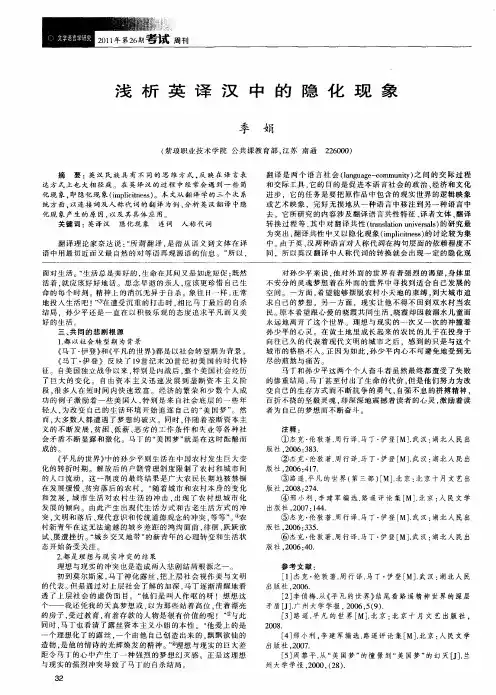
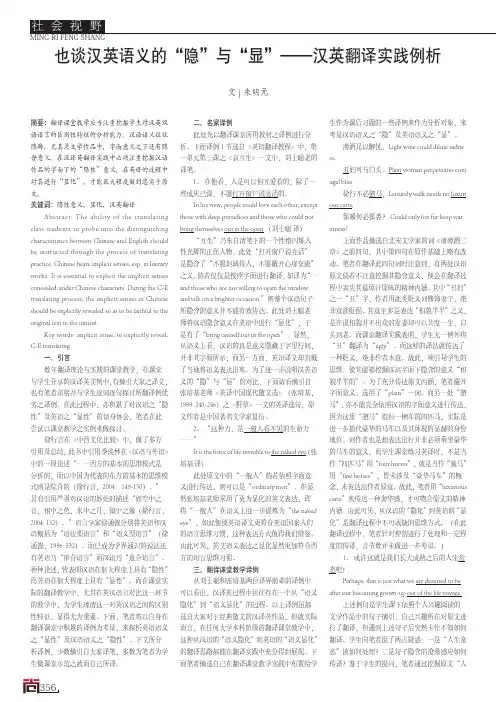
356文|朱明元也谈汉英语义的“隐”与“显”——汉英翻译实践例析摘要:翻译课堂教学应当注重挖掘学生对汉英双语语言的区别性特征的分析能力。
汉语语义往往隐晦,尤其是文学作品中,字面意义之下还有隐含意义。
在汉译英翻译实践中必须注重挖掘汉语作品的字面下的“隐性”意义,在英译的过程中对其进行“显化”,才能最大程度做到忠实于原文。
关键词:隐性意义,显化,汉英翻译Abstract: The ability of the translating class students to probe into the distinguishing characteristics between Chinese and English should be instructed through the process of translating practice. Chinese bears implicit senses, esp. in literary works. It is essential to exploit the implicit senses concealed under Chinese characters. During the C-E translating process, the implicit senses in Chinese should be explicitly revealed so as to be faithful to the original text to the utmost.Key words: implicit sense, to explicitly reveal, C-E translating一、引言数年翻译理论与实践的课堂教学,在课堂与学生分享的汉译英实例中,有摘引大家之译文,也有笔者亲躬并与学生逐词逐句探讨所翻译例优劣之译例。
在此过程中,亦积累了对汉语之“隐性”及英语之“显性”的切身体会,笔者在此尝试以课堂教学之实例来做探讨。
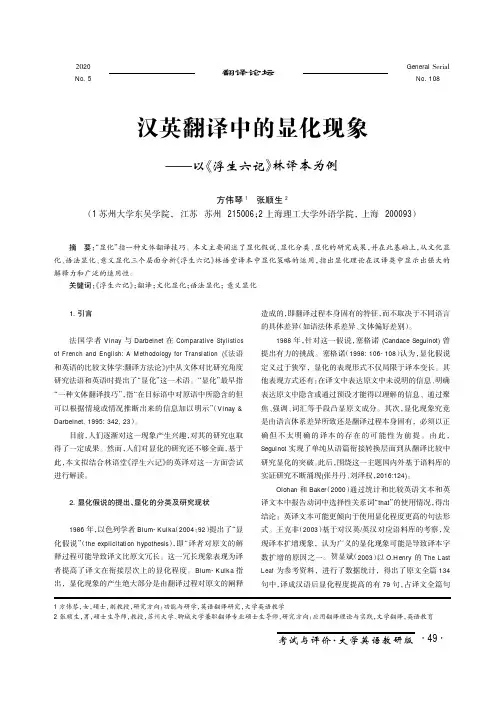
考试与评价·大学英语教研版翻译论坛General Serial No.1082020No.51方伟琴,女,硕士,副教授,研究方向:功能与研学,英语翻译研究,大学英语教学2张顺生,男,硕士生导师,教授,苏州大学、聊城大学兼职翻译专业硕士生导师,研究方向:应用翻译理论与实践,文学翻译,英语教育汉英翻译中的显化现象———以《浮生六记》林译本为例方伟琴1张顺生2(1苏州大学东吴学院,江苏苏州215006;2上海理工大学外语学院,上海200093)摘要:“显化”指一种文体翻译技巧。
本文主要阐述了显化假说、显化分类、显化的研究成果,并在此基础上,从文化显化、语法显化、意义显化三个层面分析《浮生六记》林语堂译本中显化策略的运用,指出显化理论在汉译英中显示出强大的解释力和广泛的适用性。
关键词:《浮生六记》;翻译;文化显化;语法显化;意义显化1.引言法国学者Vinay 与Darbelnet 在Comparative Stylistics of French and English:A Methodology for Translation (《法语和英语的比较文体学:翻译方法论》)中从文体对比研究角度研究法语和英语时提出了“显化”这一术语。
“显化”最早指“一种文体翻译技巧”,指“在目标语中对原语中所隐含的但可以根据情境或情况推断出来的信息加以明示”(Vinay &Darbelnet,1995:342,23)。
目前,人们逐渐对这一现象产生兴趣,对其的研究也取得了一定成果。
然而,人们对显化的研究还不够全面,基于此,本文拟结合林语堂《浮生六记》的英译对这一方面尝试进行解读。
2.显化假说的提出、显化的分类及研究现状1986年,以色列学者Blum-Kulka (2004:92)提出了“显化假说”(the explicitation hypothesis ),即“译者对原文的解释过程可能导致译文比原文冗长。
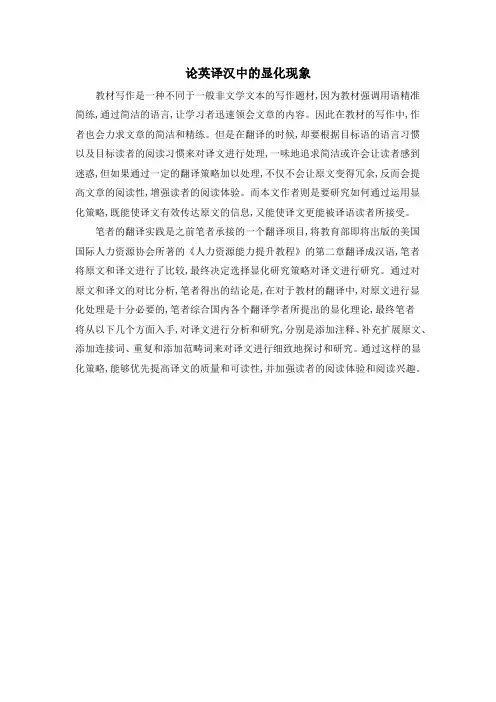
论英译汉中的显化现象
教材写作是一种不同于一般非文学文本的写作题材,因为教材强调用语精准简练,通过简洁的语言,让学习者迅速领会文章的内容。
因此在教材的写作中,作者也会力求文章的简洁和精练。
但是在翻译的时候,却要根据目标语的语言习惯以及目标读者的阅读习惯来对译文进行处理,一味地追求简洁或许会让读者感到迷惑,但如果通过一定的翻译策略加以处理,不仅不会让原文变得冗余,反而会提高文章的阅读性,增强读者的阅读体验。
而本文作者则是要研究如何通过运用显化策略,既能使译文有效传达原文的信息,又能使译文更能被译语读者所接受。
笔者的翻译实践是之前笔者承接的一个翻译项目,将教育部即将出版的美国国际人力资源协会所著的《人力资源能力提升教程》的第二章翻译成汉语,笔者将原文和译文进行了比较,最终决定选择显化研究策略对译文进行研究。
通过对原文和译文的对比分析,笔者得出的结论是,在对于教材的翻译中,对原文进行显化处理是十分必要的,笔者综合国内各个翻译学者所提出的显化理论,最终笔者
将从以下几个方面入手,对译文进行分析和研究,分别是添加注释、补充扩展原文、添加连接词、重复和添加范畴词来对译文进行细致地探讨和研究。
通过这样的显化策略,能够优先提高译文的质量和可读性,并加强读者的阅读体验和阅读兴趣。
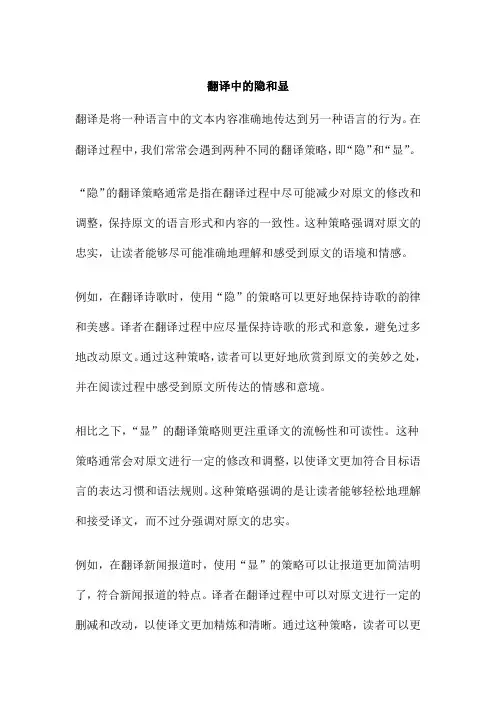
翻译中的隐和显翻译是将一种语言中的文本内容准确地传达到另一种语言的行为。
在翻译过程中,我们常常会遇到两种不同的翻译策略,即“隐”和“显”。
“隐”的翻译策略通常是指在翻译过程中尽可能减少对原文的修改和调整,保持原文的语言形式和内容的一致性。
这种策略强调对原文的忠实,让读者能够尽可能准确地理解和感受到原文的语境和情感。
例如,在翻译诗歌时,使用“隐”的策略可以更好地保持诗歌的韵律和美感。
译者在翻译过程中应尽量保持诗歌的形式和意象,避免过多地改动原文。
通过这种策略,读者可以更好地欣赏到原文的美妙之处,并在阅读过程中感受到原文所传达的情感和意境。
相比之下,“显”的翻译策略则更注重译文的流畅性和可读性。
这种策略通常会对原文进行一定的修改和调整,以使译文更加符合目标语言的表达习惯和语法规则。
这种策略强调的是让读者能够轻松地理解和接受译文,而不过分强调对原文的忠实。
例如,在翻译新闻报道时,使用“显”的策略可以让报道更加简洁明了,符合新闻报道的特点。
译者在翻译过程中可以对原文进行一定的删减和改动,以使译文更加精炼和清晰。
通过这种策略,读者可以更快地获取报道中的重要信息,而不过分依赖对原文的理解。
总之,“隐”和“显”的翻译策略在翻译过程中都有其适用范围和优缺点。
译者在翻译过程中应根据具体情况选择合适的策略,以达到最佳的翻译效果。
灯谜,又称“打灯谜”,是中国传统文化中的一种独特的语言游戏。
自南宋以来,灯谜就已经成为元宵节等节日必不可少的娱乐形式。
而在中国古代小说中,灯谜也常常被用作表现人物性格、推动情节发展的重要手段。
《红楼梦》作为中国古代文学的经典之作,其中大量的灯谜不仅富有文化内涵,还为读者呈现了丰富多彩的语言艺术。
本文将从“欲婉而正”和“欲隐而显”两个角度出发,探讨《红楼梦》灯谜及其翻译的魅力。
一、灯谜的来源及历史背景灯谜的起源可以追溯到南宋时期,当时都城临安的元宵节庆典中就有了猜灯谜的活动。
随着时间的推移,灯谜逐渐发展成为一种独特的文学形式,不仅在民间广受欢迎,也在宫廷中得到了推广。
英汉翻译中的显化和隐化[摘要]:正确认识和了解翻译中显化与隐化的因素,有助于译文的正确表达。
本文通过实例分析英汉互译中显化和隐化现象,认为它由语言、译者、社会文化等多种因素造成的,并提出了应用策略。
[关键词]:显化隐化语言特性显化(explicitness / explicitation),又译外显化、明晰化,指的是“目标文本以更明显的形式表述源文本的信息,是译者在翻译过程中增添解释性短语或添加连接词等来增强译本的逻辑性和易解性,从而使原文艰涩晦暗之处在译语中变得清晰、明白、浅显”。
而隐化(implicitness)现象是指目标文本通过概括信息或删除连接词等有意忽略或省译源语文本中的某些部分。
由于汉语在指称形式、连接词、造句结构等方面都不同于英语,两种语言互译过程中的确存在隐化现象的发生。
贺显斌曾选取欧•亨利的短篇小说The Last Leaf及其汉译本进行显化现象的比较。
他的结果是:英文小说全篇134句,译成汉语后明晰化程度提高的有79句,占58.96%,也就是说,在英译汉过程中确有显化现象发生。
一、影响显化、隐化的因素导致翻译中的显化和隐化的因素主要可归纳为三方面:一是语言特性因素。
语言本身的特性,包括结构特性和习惯用法,决定了语言表达中显、隐化程度的区别。
分析发现,汉译英时会较多地运用形式上的显化,而英译汉时意义上的隐化是普遍存在的。
二是语用因素。
基于翻译的目的在于使读者理解原文的观点,翻译者有责任将不同文化的承载内涵和文化缺失部分通过加词、阐释等方法显化表达。
三是译者因素。
过多仿译会造成过多“显化”。
1.英汉语言特性因素从语言学角度来说,汉、英语言之间最重要的区别特征莫过于形合与意合的区分,邵志洪对汉语和英语的语义对比表明,汉语属语义形语言,而印欧语言属语法形语言;前者力主考究“字”与语义及其相互关系,后者则重点研究主谓序列及其相关词类。
贾玉新将英汉语言在句法上的差异精炼的概括如下:“英语高度形式化、逻辑化,句法结构严谨完备,并以动词为核心,重分析轻意合;而汉语则不重形式,句法结构不必完备,动词的作用没有英语中那么突出,重意合,轻分析”。
汉英口译中的显化现象分析口译作为一种重要的跨文化交流方式,扮演着桥梁的角色,将一种语言文化转化为另一种语言文化。
在汉英口译过程中,显化现象是常见的现象之一。
本文将对汉英口译中的显化现象进行分析。
显化是指在口译过程中,译员将源语言中的某个语言现象或文化元素在目标语言中明确地表达出来的现象。
这种现象在汉英口译中尤为常见,因为中英两种语言文化之间存在着差异。
显化的目的是为了更好地传达源语言的信息和意图,使目标语言的听众或读者能够更好地理解。
在汉英口译中,显化现象体现在多个方面。
首先是在词语选择上。
由于中英两种语言的词汇差异,译员需要根据上下文和语言习惯,选择合适的词语进行翻译,以保证信息的准确传达。
其次是在文化背景和习惯上的显化。
中英两种文化存在着差异,因此在口译过程中,译员需要将源语言中的文化元素显化出来,使目标语言的听众或读者能够更好地理解背后的文化意义。
此外,口译中的显化还可以体现在语法结构和修辞手法上。
译员需要根据语言特点和习惯,调整句子结构和修辞方式,使其在目标语言中更自然流畅。
显化现象在汉英口译中的应用有助于提高信息的准确性和传达效果。
通过显化,译员可以将源语言中的信息和意图更好地传达给目标语言的听众或读者,使其能够更好地理解。
同时,显化也有助于促进跨文化交流和理解,减少误解和歧义。
然而,显化也存在一些挑战和难点。
首先是在选择显化的程度上需要把握好平衡。
过度显化可能使目标语言的表达过于拗口,难以理解;而过度本土化可能导致语言和文化的失真。
其次是在处理文化差异时需要具备深入的文化理解和敏感度。
只有对中英两种文化有足够的了解,才能在口译过程中准确地进行显化。
综上所述,汉英口译中的显化现象是常见的现象之一。
通过在词语选择、文化背景和习惯、语法结构和修辞手法上的显化,译员可以更好地传达源语言的信息和意图,提高信息的准确性和传达效果。
然而,显化也面临着挑战和难点,需要译员具备深入的文化理解和敏感度。
《汉英交替传译中的显化现象研究》篇一一、引言汉英交替传译作为语言交流的重要方式,其在跨文化、跨语言交际中起着举足轻重的作用。
而在这个过程中,显化现象是一种不可忽视的语际转换特点。
显化现象是指在翻译过程中,为确保译文的清晰性,对原语言中隐含的信息进行明示化的过程。
本文将围绕这一主题展开深入的研究,以期揭示显化现象在汉英交替传译中的运作机制及影响因素。
二、汉英交替传译概述汉英交替传译是国际交流中常用的翻译方式,它要求译者在短时间内理解并转换原语信息,再以流畅的英语表达出来。
在翻译过程中,由于语言间的差异,往往需要借助显化现象来确保信息的准确传递。
三、显化现象的定义及特点显化现象是指在翻译过程中,将原语言中隐含的信息进行明示化处理,以增强译文的清晰性和理解度。
其特点主要体现在两个方面:一是信息的明示性,即原语言中隐含的信息在译文中得到明确的表达;二是语篇的连贯性,即显化处理有助于增强译文的逻辑性和流畅性。
四、汉英交替传译中的显化现象分析在汉英交替传译中,显化现象尤为常见。
首先,由于汉语和英语在表达习惯、思维方式等方面存在差异,汉语中的隐含信息在英语中往往需要显化处理。
其次,为确保信息的准确传递和语篇的连贯性,译者常常需要对原语进行适当的显化处理。
此外,不同的文化背景和价值观也会影响显化策略的选择和应用。
五、显化现象的影响因素汉英交替传译中的显化现象受多种因素影响。
首先,原语的隐含信息程度是影响显化的关键因素。
当原语信息隐含度较高时,显化程度也会相应增加。
其次,翻译者的能力和风格对显化处理有着显著的影响。
翻译者的语言表达能力和文化背景知识水平直接影响着其对隐含信息的捕捉和处理。
最后,文化差异也是影响显化的重要因素。
不同的文化背景下,人们对于信息的理解和表达方式存在差异,这也决定了翻译过程中的显化策略有所不同。
六、提高汉英交替传译中显化现象的策略为提高汉英交替传译中的显化效果,可以采取以下策略:一是加强原语理解能力,准确捕捉隐含信息;二是提高语言表达能力,将隐含信息明示化;三是了解文化背景和价值观差异,选择合适的显化策略;四是加强实践训练,提高翻译能力和经验积累。
《汉英交替传译中的显化现象研究》篇一一、引言随着全球化进程的加速,汉英交替传译在跨文化交流中发挥着越来越重要的作用。
然而,由于中英两种语言在表达方式和逻辑结构上的差异,翻译过程中常常会出现一些特殊的语言现象,其中显化现象尤为突出。
本文旨在研究汉英交替传译中的显化现象,探讨其成因、表现形式及应对策略,以期为翻译实践提供一定的指导。
二、显化现象的成因及表现形式显化现象是指在翻译过程中,由于语言结构和表达习惯的差异,源语中的隐含信息在译语中得以明确表述的现象。
在汉英交替传译中,显化现象的产生主要有以下几个方面的原因:1. 语言结构差异:汉语重意合,信息多隐含在语境中,而英语重形合,信息往往需要通过明确的语法结构和词汇来表达。
2. 文化背景差异:中西方文化背景、价值观念和思维方式的不同,导致对同一信息的理解和表达存在差异。
3. 翻译策略选择:译者在翻译过程中,为了更好地传达原文信息,有时会采用显化的翻译策略。
显化现象在汉英交替传译中的表现形式多种多样,如:1. 词汇显化:原句中的隐含信息在译句中通过明确的词汇得以表达。
2. 句法显化:原句中的意合结构在译句中通过形合结构得以明确表达。
3. 文化背景显化:原句中的文化背景信息在译句中得以明确介绍或解释。
三、显化现象对翻译实践的影响显化现象对汉英交替传译实践具有重要影响。
一方面,显化有助于提高译文的准确性和可读性,使译文更好地传达原文信息;另一方面,过度显化可能导致译文冗长、不够精炼。
因此,译者需要掌握适当的显化策略,以达到既准确又简洁的翻译效果。
四、应对显化现象的策略为了有效应对汉英交替传译中的显化现象,译者可以采取以下策略:1. 熟悉中英语言差异:了解汉语和英语的表达习惯、语法结构和文化背景等方面的差异,为翻译过程中的显化现象做好准备。
2. 掌握翻译技巧:灵活运用增译、减译、转译等翻译技巧,根据具体情况选择合适的显化策略。
3. 提高语言素养:加强英语表达能力和汉语理解能力的训练,提高对复杂句子的处理能力。
《汉英交替传译中的显化现象研究》篇一一、引言交替传译是国际交流中的常见方式,而汉英交替传译又是其中的重要一环。
在汉英交替传译过程中,显化现象是一种常见的语言现象,它对翻译的准确性和流畅性有着重要的影响。
本文旨在研究汉英交替传译中的显化现象,分析其产生的原因、表现形式和影响,并提出相应的翻译策略。
二、显化现象的定义及产生原因显化现象是指在翻译过程中,为使译文更易于理解、更符合目标语言的表达习惯,译者将原文中的隐含信息明确表达出来的现象。
在汉英交替传译中,显化现象的产生主要有以下原因:1. 语言差异:汉语和英语在语言表达上存在较大差异,如汉语中的意合和英语中的形合。
在翻译时,为使译文更符合目标语言的表达习惯,需要进行显化处理。
2. 文化背景:中西方文化背景、思维方式存在差异,导致对同一事物的理解和表达方式不同。
为消除文化差异带来的误解,需要进行显化处理。
3. 语境需求:在特定的语境下,为使译文更准确地传达原文信息,需要进行显化处理。
例如,在涉及政治、经济、法律等领域的翻译中,显化现象尤为明显。
三、显化现象的表现形式在汉英交替传译中,显化现象的表现形式多种多样,主要包括以下几种:1. 词汇显化:通过明确翻译原文中的词汇含义,使译文更易于理解。
例如,将“龙头企业”翻译为“leading enterprise”。
2. 结构显化:调整原文的结构顺序,使其更符合目标语言的表达习惯。
例如,将无主语句翻译为有主语句。
3. 语境显化:通过明确语境信息,使译文更准确地传达原文信息。
例如,在翻译时添加解释性文字或背景信息。
四、显化现象的影响及翻译策略显化现象对汉英交替传译的准确性和流畅性有着重要的影响。
一方面,适当的显化处理可以使译文更易于理解、更符合目标语言的表达习惯;另一方面,过度的显化处理可能导致译文冗长、不自然。
因此,在翻译过程中需要把握好显化的度。
针对汉英交替传译中的显化现象,可采取以下翻译策略:1. 了解语言和文化差异:熟悉汉语和英语的表达习惯、文化背景等方面的差异,为显化处理提供依据。
英汉翻译中的显化和隐化
[摘要]:正确认识和了解翻译中显化与隐化的因素,有助于译文的正确表达。
本文通过实例分析英汉互译中显化和隐化现象,认为它由语言、译者、社会文化等多种因素造成的,并提出了应用策略。
[关键词]:显化隐化语言特性
显化(explicitness / explicitation),又译外显化、明晰化,指的是“目标文本以更明显的形式表述源文本的信息,是译者在翻译过程中增添解释性短语或添加连接词等来增强译本的逻辑性和易解性,从而使原文艰涩晦暗之处在译语中变得清晰、明白、浅显”。
而隐化(implicitness)现象是指目标文本通过概括信息或删除连接词等有意忽略或省译源语文本中的某些部分。
由于汉语在指称形式、连接词、造句结构等方面都不同于英语,两种语言互译过程中的确存在隐化现象的发生。
贺显斌曾选取欧•亨利的短篇小说The Last Leaf及其汉译本进行显化现象的比较。
他的结果是:英文小说全篇134句,译成汉语后明晰化程度提高的有79句,占58.96%,也就是说,在英译汉过程中确有显化现象发生。
一、影响显化、隐化的因素
导致翻译中的显化和隐化的因素主要可归纳为三方面:一是语言特性因素。
语言本身的特性,包括结构特性和习惯用法,决定了语言表达中显、隐化程度的区别。
分析发现,汉译英时会较多地运用形式上的显化,而英译汉时意义上的隐化是普遍存在的。
二是语用因素。
基于翻译的目的在于使读者理解原文的观点,翻译者有责任将不同文化的承载内涵和文化缺失部分通过加词、阐释等方法显化表达。
三是译者因素。
过多仿译会造成过多“显化”。
1.英汉语言特性因素
从语言学角度来说,汉、英语言之间最重要的区别特征莫过于形合与意合的区分,邵志洪对汉语和英语的语义对比表明,汉语属语义形语言,而印欧语言属语法形语言;前者力主考究“字”与语义及其相互关系,后者则重点研究主谓序列及其相关词类。
贾玉新将英汉语言在句法上的差异精炼的概括如下:“英语高度形式化、逻辑化,句法结构严谨完备,并以动词为核心,重分析轻意合;而汉语则不重形式,
句法结构不必完备,动词的作用没有英语中那么突出,重意合,轻分析”。
因此,英译汉时注重“神合”,在词语处理方面应体现出汉语的特色,看下例:
(1) We live and learn.
活到老,学到老。
we是泛指的英语人称代词,在英语句中必不可少,在汉语中却是无需译出的。
如果译出,变为“我们活到老,学到老”,反而将句意限定得过于狭窄,失去了其普遍性意义。
(2) Outside it was pitch and dark and it was raining cats and dogs.
外面一团漆黑,大雨倾盆。
此中的it无法译出,汉语中根本就不存在与其对应的表达。
这是由于语言结构的差异所造成的,汉语句式可以不要主语而准确表达众所周知的意思,英语则要求句式结构严谨,主、谓、宾俱全。
再请看如下汉译英的例子。
(3)靠山吃山,靠水吃水,我老汉靠沙子,当然要吃沙
If you live on a mountain, you live off the mountain; if you live by the water, you live off the water. I live on the sand, and I’ll live off the sand.
(4)国家这么大,这么穷,不努力发展生产,日子怎么过?
In a country as big and as poor as ours, if we don’t try to increase production, how can we survive?
在以上的例句中,因英文表达的需要,汉语原文的隐性条件句在翻译成英文时都加上了if,汉语中的假设意思被显化了。
2.语用因素
语用因素,即为了把原文中隐含的文化信息和文本的意图表露出来,在译文中增添有助于译文读者理解和认知的表达方式。
如把“Kleenex”写成“克林尼克斯牌手纸”。
语用“显化”的原因是原文中的共知信息或意图在译文中变成了非共知信息或意图,但它又是作者意欲表达的一部份,隐含信息需要传达出去,需要读者领悟。
3.译者因素
负责的译者在穿梭于两种语言之间进行协调时,总会尽量减少信息传输过程中的损耗和丢失,便于读者的理解和吸收。
但有些译者因其能力上的不足,在翻译中对原文亦步亦趋地仿译,也会导致译文过度“显化”。
二、显化、隐化策略的应用
1.更为地道的表达
在翻译中适当采取显、隐化策略,可以使译文更贴合目的语表达习惯。
下面我们通过具体实例说明这一点。
(1) If you take this medicine, your illness will surely be cured.
(2)你要是服用这个药,你的病肯定能治好。
(3)这药吃了准好。
(4) You needn’t care about the affairs in the home.
(5)你不必担心家里的事。
(6)家里的事,不用你管。
显然,上述汉译文(3),(6)句运用了隐化策略后更加地道、简洁,符合中国人的口语表达习惯。
(2),(4)为明显的仿译,它将外语的表达法引入汉语,原本可以隐化的人称代词被显化到译文中,成了“带洋味儿”的汉语。
2.阐译
许国璋曾提出应采取“通译”、“切译”或“阐译”、“释译”方法,力主译文必须通脱、醒豁,译出词的文化史涵义。
他特地翻译罗素《西方哲学史》以为其“阐译”示范。
他解释说:feudal不译“封建”,译“拥据领地(之诸侯)”;anarchy不译“无政府”(当时无中央政府),而译“诸侯纷争”;adventure不译“冒险”,或译“猎奇于远方”,或译“探无涯之知”,视上下文而定。
3.称谓语的灵活处理
英语的称谓相对简单、分类单一,许多称谓语可以一词表示多个亲属关系。
例如aunt一词可以表示汉语中的姨母、姑母、伯母、婶母、舅母、阿姨、大娘七种称谓。
在汉译英时,可以统一译为aunt;如果称谓所表达的亲属关系与上下文的理解有密切关系,则需要将这种关系具体阐释,在目的语中显化源语言内在的涵义。
三、结束语
针对翻译中隐化和显化的不可避免性,我们可以充分利用这种现象为翻译服务。
合理运用显、隐化策略可以帮助译者更灵活地表达原文涵义,达到翻译促成不同语言间表意理解和文化交流的目的。
参考文献:
[1]柯飞.2005.翻译中的隐和显[J].外语教学与研究.
[2]贺显斌.英汉翻译过程中的明晰化现象[J].解放军外国语学院学报,2003,(4).
[3]贾玉新.跨文化交际学.上海:上海外语教育出版社,1997.32.
[4]邵志洪.汉英对比翻译导论.上海:华东理工大学出版社,2005.32.。